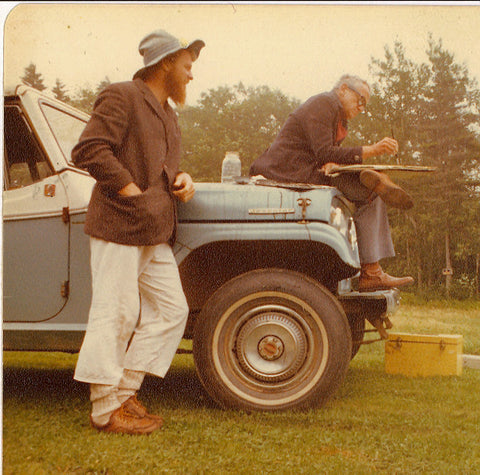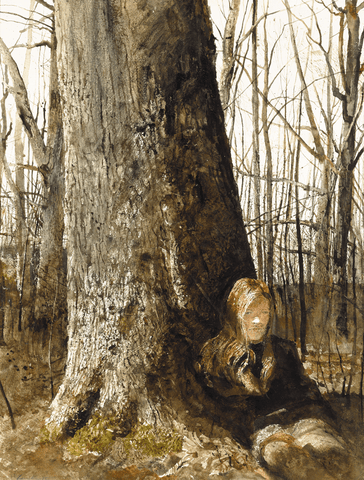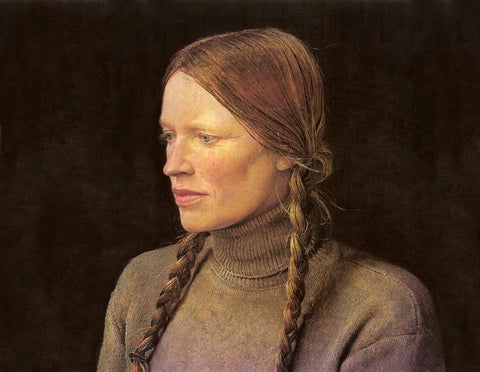In the Summer of 1985, while on a drive in their eggplant-colored Stutz Blackhawk, Andrew Wyeth revealed to his wife that he had been working on a series of paintings for the past 15 years without her knowledge. The only other person who knew about them was the model - their neighbor, Helga Testorf. By this time, Wyeth was already a behemoth of 20th-century American painting and American fine art, and the series that would come to be known as The Helga Pictures cemented his legacy as one of the greatest and most enigmatic American artists in history.
It is a rare and serendipitous occurrence in the art world to discover a previously unknown work by a great artist, but discovering an entire series of sketches and paintings in an entire collection - over 240 - all kept hidden away by the artist himself is unheard of. This series of antique portrait paintings was only revealed by Wyeth after he contracted the flu at age 68 and feared he was dying. Why was the Helga series kept secret? For art, love, or publicity?
In this article, we are going to review everything you need to know about the interesting art stories regarding Andrew Wyeth and the Helga pictures. If you’re interested in these stunning pieces of work, you can then browse our selection of Wyeth paintings, among other rare pieces of art in our collection.
"The more I'm with an object — whether it's a model or a piece of the country — the more I begin to see what I've been blind to. You start to get what's beneath it. You see deeper within it.“ -Andrew Wyeth

Caption: Wyeth (right) paints en plein air, 1977.
The Helga Pictures are a series of quiet, thoughtful portraits of Helga Testorf presented both clothed and nude in various locations indoors and out. These rare paintings were created from 1971 until 1785 in almost complete secrecy. Both artist and model kept the extent of this creative union hidden from their respective spouses, and Wyeth kept most of the works hidden in the loft of a millhouse on his property at Chadds Ford in rural Pennsylvania.
Betsy Wyeth of course knew that her husband often employed the use of models (perhaps his most famous piece, Christina’s World, featured another one of their neighbors as a model) and even knew he had painted Helga, but she had no idea the extent of the special creative relationship he had with her. Helga’s husband knew that Wyeth had painted his wife (the artist had even asked his permission), but he had made him promise to never paint her in the nude. So, when the sheer amount of these portraits and the level of intimacy and secrecy involved came to light, their spouses, the small town of Chadds Ford, and the country was taken aback.
However, Betsy Wyeth, a savvy business manager, was not fazed for long and immediately recognized the artworks’ beauty and importance. The Wyeths invited art collector Leonard E.B. Andrews to their home to view the pictures. Andrews called them “a national treasure” and purchased the entire collection of finished works for an undisclosed sum of multi-millions of dollars. The next year, in 1987, the Helga series was exhibited at the National Gallery in Washington, D.C., and then embarked on a traveling exhibition tour around the world.
The discovery shook the art world. The story appeared on the covers of both Time Magazine and Newsweek, and people speculated on the nature of the paintings and the artist’s relationship to the model. Betsy, perhaps capitalizing on the media frenzy, stated simply that the Helga Pictures were about “Love.” Rumors flew of an affair that was denied by all involved; however, Andrew Wyeth had famously said he required a special relationship with his models because he considered painting a private, intimate act. There was also speculation that nothing had been a secret after all, and that it was an orchestrated publicity stunt, which that artist also denied.
“I think anything like that — which is contemplative, silent, shows a person alone — people always feel is sad. Is it because we’ve lost the art of being alone?”
- Andrew Wyeth

One of the Helga paintings from the series, executed in 1973, entitled Seated by a Tree depicts Helga lost in thought at the base of a large tree trunk in the middle of a forest in winter. She is almost hidden away — dwarfed by the tree, dappled in shadow, and bundled up in her winter clothes — absorbed in a private moment. The painting displays Wyeth’s signature, highly textural use of watercolor, and his emotional, melancholy style. It is one of the finest of the Helga Pictures, and it can tell us a great deal about the series as a whole.
One overarching theme throughout The Helga Pictures is the tension between privacy and exposure — a moment just before discovery or a moment you choose to share with a select few. It was a fitting theme, considering how private Wyeth was personally, and the secrecy surrounding the creation of the series. Helga was one of Wyeth’s famous muses and was likely his favorite model. She sat for the artist for hours at a time, perfectly still and content. In these artworks, Wyeth is able to translate the intimate partnership and the secret language they shared for the viewer, giving us access to their private moments. Maybe it was this intense, sometimes uncomfortably earnest intimacy that fueled the scandal surrounding the series of Helga paintings.
For instance, Helga is often painted nude in the series, but she is frequently sleeping, back turned, or her face or body is obscured in some way. Somewhat ironically, when she is clothed, as in Seated by a Tree, the tension surrounding the private moment becomes even more palpable. Wyeth uses Helga’s surroundings as a clue to her or the artist’s mood — the black void of a doorway, a window looking out on the world, the expanse of a field, or, as in Seated by a Tree, the winter trees laid bare. Their exposed limbs stand in stark contrast to Helga dressed in a heavy coat, suggesting a certain vulnerability. It exemplifies Wyeth’s ability to create portraits of a state of mind rather than of a person or a place.
“People talk to me about the mood of melancholy in my pictures. Now, I do have this feeling that time passes — a yearning to hold something — which might strike people as sad... I think the right word is not ”melancholy“ but ”thoughtful.“
-Andrew Wyeth

The creation and subsequent emergence of The Helga Pictures was a singular event in American art history. A major 20th-century painter revealed scores of unknown works. With their exposure, realism suddenly became sensational in an increasingly conceptual art world. Never had a contemporary artist created such a moving and tender collection of portraits of a single model; Helga has since been described as “the last person made famous by a painting.” Perhaps unsurprisingly The Helga Pictures remain coveted by museums and collectors for their emotional power and art-historical significance.
Little was ever said by Helga Testorf or the Wyeths to shed light on the nature of the series. As rumors whirled about love, affairs, and publicity stunts, the works spoke for themselves, and what remains is a visual examination of intimacy and vulnerability, unlike anything else in contemporary art.
Sources:
Corliss, Richard. “Art: Andrew Wyeth's Stunning Secret.” Time. Time Inc., August 18, 1986. http://content.time.com/time/subscriber/article/0,33009,962060-1,00.html.
Mcgill, Douglas C. “HELGA'S WORLD: THE SECRET ART OF ANDREW WYETH.” The New York Times. The New York Times, August 17, 1986. https://www.nytimes.com/1986/08/17/arts/helga-s-world-the-secret-art-of-andrew-wyeth.html.
“Sex Is Sex, Love Is Love, Hype Is Hype.” Los Angeles Times. Los Angeles Times, August 15, 1986. https://www.latimes.com/archives/la-xpm-1986-08-15-me-3817-story.html.
Wyeth, Andrew, and John Wilmerding. Andrew Wyeth: the Helga Pictures. New York: H.N. Abrams, 1987.



